Toyama has many fish markets – but only one authentic fish market (like the famous Tokyo fish markets) where the Japanese visitors go to get their fresh yellow tail sashimi. Since we had a bit of time after work – we decided to head to the port area and see a few of them. We drove through some very picturesque rice paddy fields on the way there… one thing I have noticed about the Japanese landscape is that it’s almost impossible to get away from their power grid infrastructure when attempting to take pictures – it’s ALL above ground and it’s higgeldy piggeldty everywhere. 
 This warning is sign says “water!”, but is presumably meant to be read more like “WATER!” to let hapless passers-by know that there may be water in the rice paddy fields? The roads are all largely built up on banks about 3-4 feet above the level of the rice/water but I imagine plenty of people end up driving into the drink with the way people habitually speed around here. There’s some legislative loophole here where the police can’t have speed cameras as it is illegal to film someone unless they are engaged in illegal activity. So the convention (ie: the internet) says that you can do up to 39km per hour over the speed limit in a 100 zone, and up to 29km per hour over the posted speed limit in a 60 zone before the cops will care at all; because that is the limit where disqualification of license is the penalty. The result of which is EVERYONE is doing 70 in a 50 zone and so on…
This warning is sign says “water!”, but is presumably meant to be read more like “WATER!” to let hapless passers-by know that there may be water in the rice paddy fields? The roads are all largely built up on banks about 3-4 feet above the level of the rice/water but I imagine plenty of people end up driving into the drink with the way people habitually speed around here. There’s some legislative loophole here where the police can’t have speed cameras as it is illegal to film someone unless they are engaged in illegal activity. So the convention (ie: the internet) says that you can do up to 39km per hour over the speed limit in a 100 zone, and up to 29km per hour over the posted speed limit in a 60 zone before the cops will care at all; because that is the limit where disqualification of license is the penalty. The result of which is EVERYONE is doing 70 in a 50 zone and so on…  This is the first ‘fish market’ we visited – the Shinminato Kittokito Fisherman’s Market. We did not stay long,… there were no workmen sorting and slinging about their fresh catch. There were no barrels and barrels of fish splayed out on ice waiting to be auctioned – so we determined it is a ‘tourist fish market’. A suspicion that was borne out when a bus load of Chinese tourists came in and started shoving each other out of their way to get to a large and very modern canteen. Not a bad spot if you want preserved fish products and souvenirs, but the place doesn’t even smell like fish and there isn’t any seabirds anywhere!
This is the first ‘fish market’ we visited – the Shinminato Kittokito Fisherman’s Market. We did not stay long,… there were no workmen sorting and slinging about their fresh catch. There were no barrels and barrels of fish splayed out on ice waiting to be auctioned – so we determined it is a ‘tourist fish market’. A suspicion that was borne out when a bus load of Chinese tourists came in and started shoving each other out of their way to get to a large and very modern canteen. Not a bad spot if you want preserved fish products and souvenirs, but the place doesn’t even smell like fish and there isn’t any seabirds anywhere! 
 There is plenty of shopping here to lighten your wallet, and it is redeemed a teeny bit by having an amazing little saké shop.
There is plenty of shopping here to lighten your wallet, and it is redeemed a teeny bit by having an amazing little saké shop. I had heard (read: saw someone raving about it on a YouTube video), about the famous shrimp flavoured ice cream here and felt that must be pretty weird so naturally had to buy one to try it.
I had heard (read: saw someone raving about it on a YouTube video), about the famous shrimp flavoured ice cream here and felt that must be pretty weird so naturally had to buy one to try it. Mr K said “That is the most Instagrammable thing I have ever seen you do – spend 350JPY on an ice cream because someone else on the internet did!” To which I replied, it’s only the most Instagrammable thing you’ve ever seen me do if I buy it, take a photo, post it on bloody Instagram and then dump it!” Which wasn’t my intention, but I have to say it tasted bloody ordinary, so most of it did unfortunately end up in the bin. Whoops!
Mr K said “That is the most Instagrammable thing I have ever seen you do – spend 350JPY on an ice cream because someone else on the internet did!” To which I replied, it’s only the most Instagrammable thing you’ve ever seen me do if I buy it, take a photo, post it on bloody Instagram and then dump it!” Which wasn’t my intention, but I have to say it tasted bloody ordinary, so most of it did unfortunately end up in the bin. Whoops!  And he has the audacity to pick on me and my ice cream… exhibit A, if it may please the court:
And he has the audacity to pick on me and my ice cream… exhibit A, if it may please the court:
Translated for your enjoyment: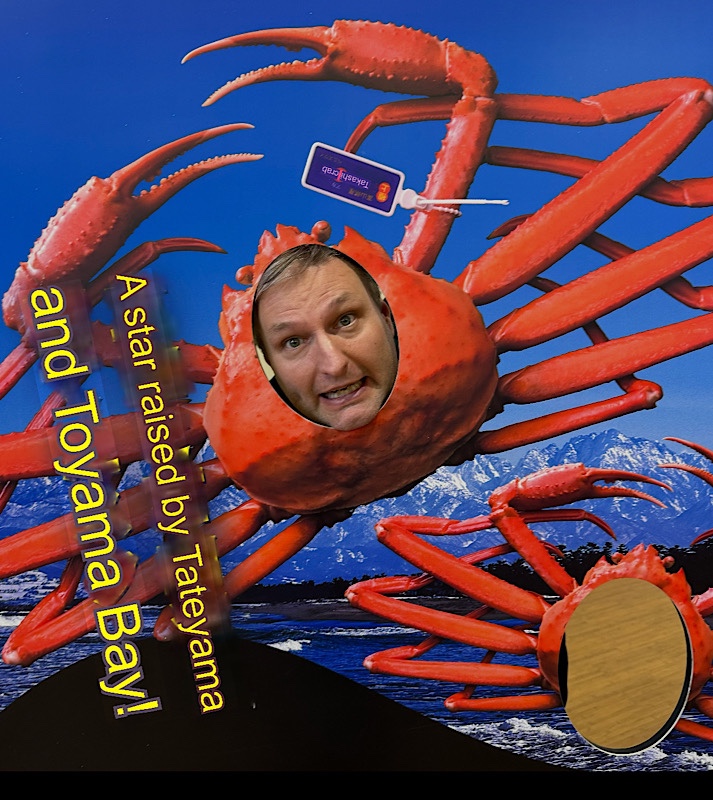
Next we went to the Himi Port fish market. Now this one I knew was going to be the real deal. The only reason I knew about it is from seeing a Japanese man reviewing how he came all the way from Tokyo to have fresh yellow tail sashimi here and that the restaurant (singular) is always busy and it is through this obscurely signed door. I have no idea what the restaurant is called but it shows up as ‘地方卸売市場 氷見漁港’ on google maps. I’m sure the restaurant has a name – but I have no idea what it is.  Yep! Okay, this is definitely a fish market. Fresth fishy smell -check. Wet concrete everywhere – check. Seabirds squabbling all over the place – check! We arrived around 1pm and all the auctions for the morning’s catches were over but the restaurant was busy as all giddy up – as promised. So we took a number and waited to be called. Which took about 20 mins given the time of day.
Yep! Okay, this is definitely a fish market. Fresth fishy smell -check. Wet concrete everywhere – check. Seabirds squabbling all over the place – check! We arrived around 1pm and all the auctions for the morning’s catches were over but the restaurant was busy as all giddy up – as promised. So we took a number and waited to be called. Which took about 20 mins given the time of day.
 Inside was a modern hustling restaurant that seated about 60 and was half closed off (I think it’s off season now for visitors). Mr K liked the robot waiters, I was drooling over the menu.
Inside was a modern hustling restaurant that seated about 60 and was half closed off (I think it’s off season now for visitors). Mr K liked the robot waiters, I was drooling over the menu.  Some boring non-descript fish and rice for Mr K, which was served with a optimistically labeled bottle of ‘SAUCE’ that turned out to be ponzu. LOL.
Some boring non-descript fish and rice for Mr K, which was served with a optimistically labeled bottle of ‘SAUCE’ that turned out to be ponzu. LOL. Naturally, when there is no soft drinks on the menu (that one is able to decipher) saké is the go-to whether it’s lunch or dinner (hell, I’d probably have saké for breakfast if it was an option…). I have no idea what brewery it came from but it was very quaffable.
Naturally, when there is no soft drinks on the menu (that one is able to decipher) saké is the go-to whether it’s lunch or dinner (hell, I’d probably have saké for breakfast if it was an option…). I have no idea what brewery it came from but it was very quaffable.  And then… the main events! The mixed sashimi platter full of all good things.
And then… the main events! The mixed sashimi platter full of all good things. And a yellow tail platter full of, well, yellow tail. BEST SASHIMI I have ever tried in my entire life. Quite five times better than anything Sono in Brisbane has ever served. *chef’s kiss* totally worth the mystery drive and the wait above the busy fish market. Don’t be taken in by Tourist Fish Market in Toyama, people!
And a yellow tail platter full of, well, yellow tail. BEST SASHIMI I have ever tried in my entire life. Quite five times better than anything Sono in Brisbane has ever served. *chef’s kiss* totally worth the mystery drive and the wait above the busy fish market. Don’t be taken in by Tourist Fish Market in Toyama, people!
We do however, decide to go for a drive to the other fish market that I had seen online, Himi Banya-Gai (mostly because it was barely three minutes drive from the authentic one).  Himi Banya-Gai. This one is sooo touristy it even comes with its own tourist information centre, a government looking facilities block and about seven fishy canteens, a glass shop, shops full of pastries and preserved fish products – so much so you feel like you are in the food hall of a major department store.
Himi Banya-Gai. This one is sooo touristy it even comes with its own tourist information centre, a government looking facilities block and about seven fishy canteens, a glass shop, shops full of pastries and preserved fish products – so much so you feel like you are in the food hall of a major department store.
 This is what passed for premium fresh yellow tail here: some weird foil wrapped packets labeled 1st class, 2nd class and 3rd class yellow tail. And all for way more than what we paid at the port.
This is what passed for premium fresh yellow tail here: some weird foil wrapped packets labeled 1st class, 2nd class and 3rd class yellow tail. And all for way more than what we paid at the port.  The squidly products looked interesting, but without refrigeration to take them with us, they stayed in the shop.
The squidly products looked interesting, but without refrigeration to take them with us, they stayed in the shop. 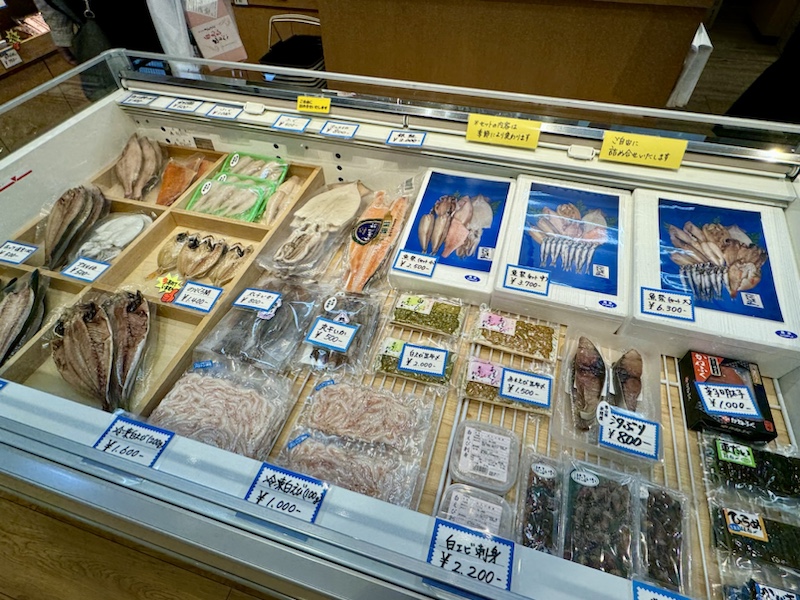

 All pre-packaged fish products. 🙁 I’m sure it makes a nice trip out here if you live in the area to stop up on pantry staples, but I’m so glad we found the port restaurant for some super fresh offerings.
All pre-packaged fish products. 🙁 I’m sure it makes a nice trip out here if you live in the area to stop up on pantry staples, but I’m so glad we found the port restaurant for some super fresh offerings. 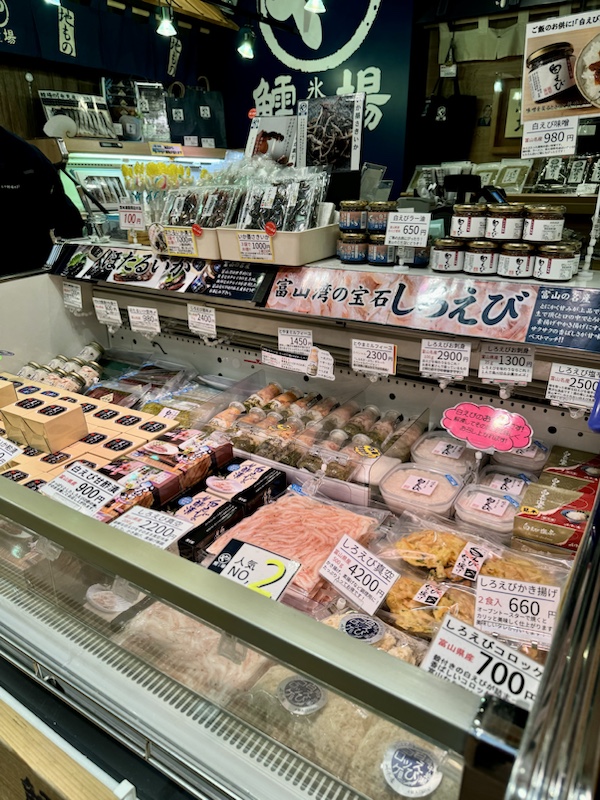
 Ah, finally some fresh fish – for you to buy and take home and prepare…?
Ah, finally some fresh fish – for you to buy and take home and prepare…?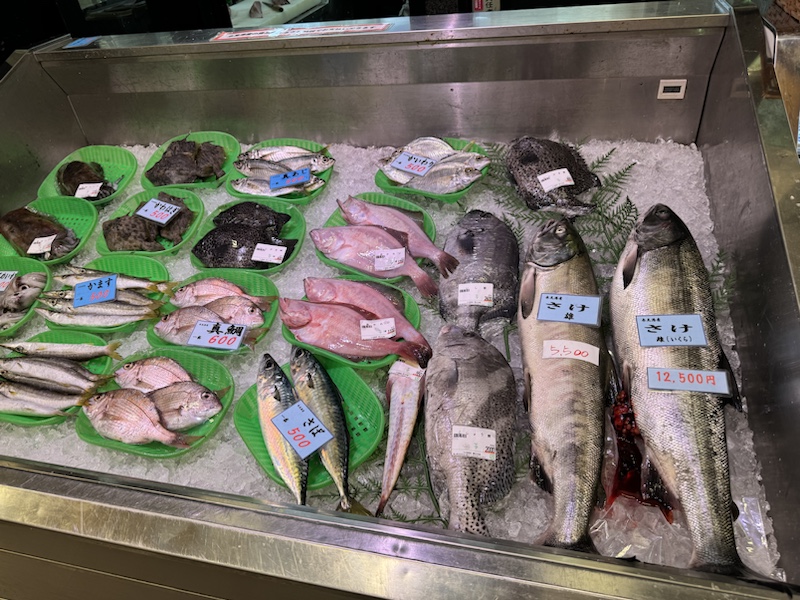

“This is Himibozu-Kuhn- a cheerful Umibozu child from the sea of Himi. He is always carrying a fishing rod and catching yellowtail. Happiness comes when you pat his head.” 
After the fish market/s we made our way back to Toyama and on the way through town dis a blockie to have a look at the Toyama Castle. It was getting a bit later and closing very shortly so we decided not to attempt to go visit. It looks very much like other castles we have visited in Osaka and Aomori – I love the Japanese castle style.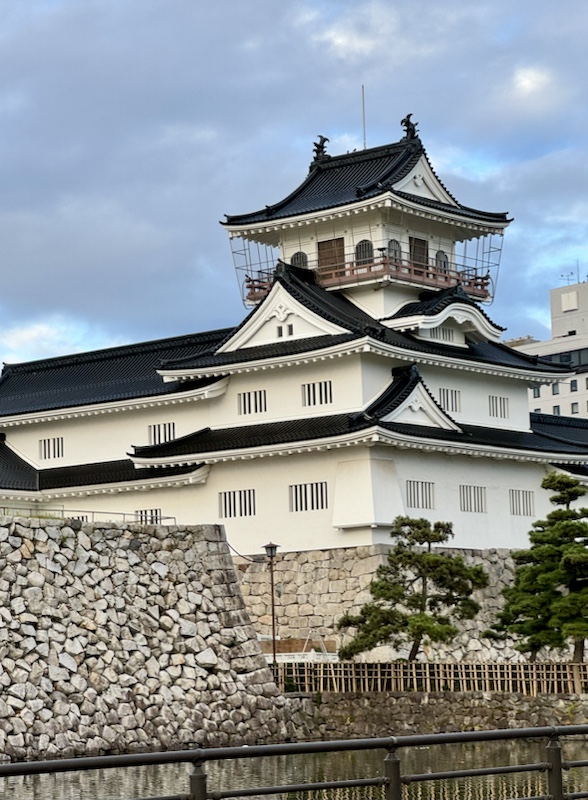 The original castle was built in the 1500s but this building is a replica re-built in the mid-1800s after an earthquake, which is quite a common story with Japanese castles.
The original castle was built in the 1500s but this building is a replica re-built in the mid-1800s after an earthquake, which is quite a common story with Japanese castles.  From there it was back to our lodgings at the Dormy Inn Toyama and would you believe it? More saké was on the menu, and tonight a cheap and dirty take-away curry for dinner. Long day was long.
From there it was back to our lodgings at the Dormy Inn Toyama and would you believe it? More saké was on the menu, and tonight a cheap and dirty take-away curry for dinner. Long day was long.


We like the Dormy Inn btw – it’s a fairly common chair here. Think something like a Rydges or a Novotel but with smaller rooms 🙂 It’s reliably clean, tidy and will have public onsens baths if you want to visit them and decent breakfasts.

 The building itself is quite impressive with the most amazing open atrium…
The building itself is quite impressive with the most amazing open atrium… 
 At the moment the 6th floor houses a large exhibition show casing the works of Dale Chihuly – an American glass artist who is various lauded as either overrated (given a lot of his production is done in a workshop with a plethora of unnamed artists) or iconic, as he most definitely had a huge global impact on the glass arts over the last fifty years.
At the moment the 6th floor houses a large exhibition show casing the works of Dale Chihuly – an American glass artist who is various lauded as either overrated (given a lot of his production is done in a workshop with a plethora of unnamed artists) or iconic, as he most definitely had a huge global impact on the glass arts over the last fifty years.

 Toyama Reeds – 2015. This piece is 3m wide, by 4m deep and 5.3m high. These blue glass reeds are very impressive and give the impression of looking through a glass forest.
Toyama Reeds – 2015. This piece is 3m wide, by 4m deep and 5.3m high. These blue glass reeds are very impressive and give the impression of looking through a glass forest. Toyama Persian Ceiling – this installation work is most reminiscent of the ceilings in the Bellagio Hotel in Las Vegas and was created around the time when Chihuly’s primary interest was in sea forms and creating these large ridged / fluted plates.
Toyama Persian Ceiling – this installation work is most reminiscent of the ceilings in the Bellagio Hotel in Las Vegas and was created around the time when Chihuly’s primary interest was in sea forms and creating these large ridged / fluted plates. 
 Toyama Float Boat – 2015, glass 9m long, 60cm high and 65cm wide comprised of 117 boat ‘floats’. This is an amazing piece! Yes it is mostly large balls of glass, artfully arranged in brilliant colours, but it also looks like a boat full of planets, or marbles, or sweets, or Christmas baubles. It is colourful, playful and really visually attractive.
Toyama Float Boat – 2015, glass 9m long, 60cm high and 65cm wide comprised of 117 boat ‘floats’. This is an amazing piece! Yes it is mostly large balls of glass, artfully arranged in brilliant colours, but it also looks like a boat full of planets, or marbles, or sweets, or Christmas baubles. It is colourful, playful and really visually attractive. 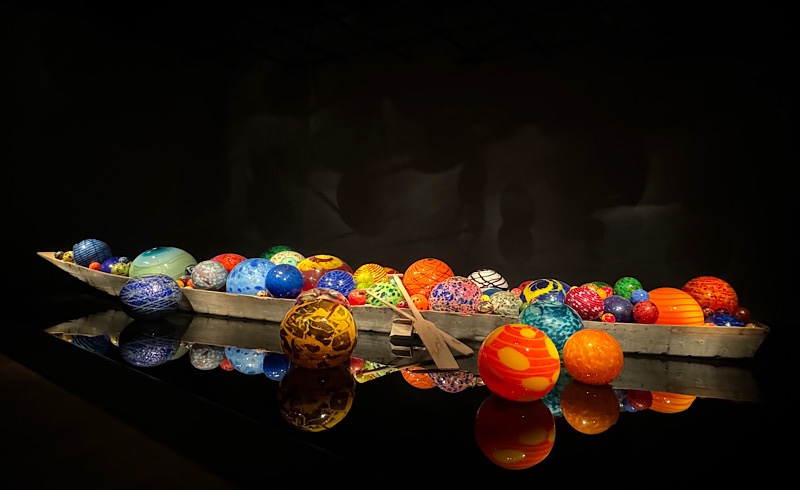
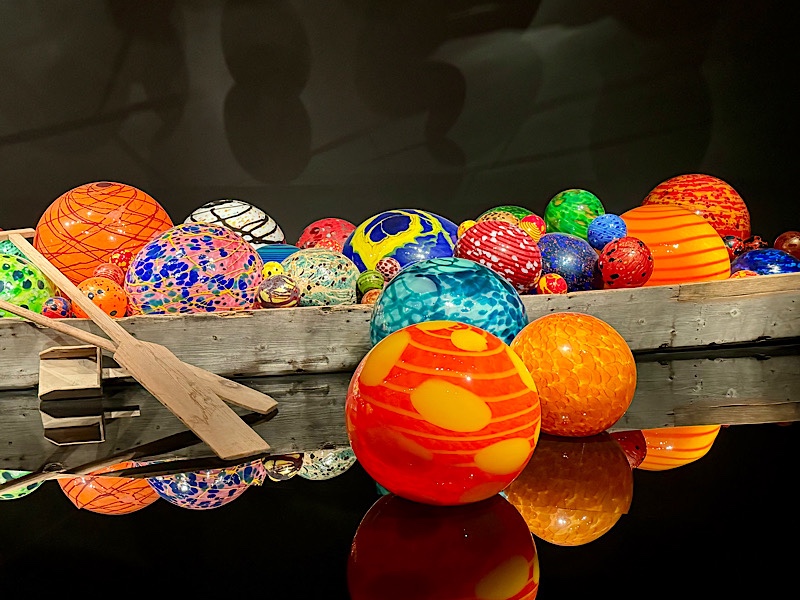


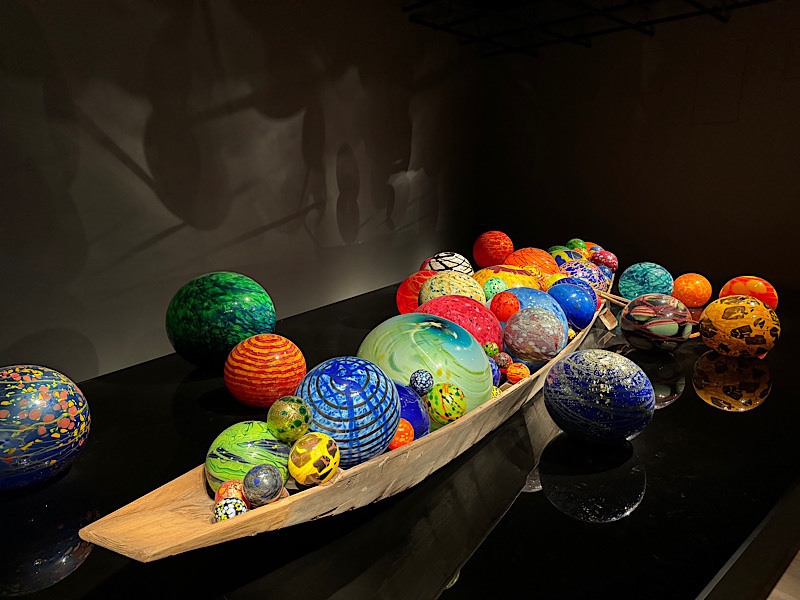 The next Chihuly in the exhibition is the Toyama Mille Fiori – also from 2015, it is an enormous 9m wide, 5.8m deep and 2.8m tall. The reeds, spirals spikes and balls in this ‘garden’ work together in the dark installation space to creat an alien-like garden that seems to change from every different angle it is viewed from.
The next Chihuly in the exhibition is the Toyama Mille Fiori – also from 2015, it is an enormous 9m wide, 5.8m deep and 2.8m tall. The reeds, spirals spikes and balls in this ‘garden’ work together in the dark installation space to creat an alien-like garden that seems to change from every different angle it is viewed from. 
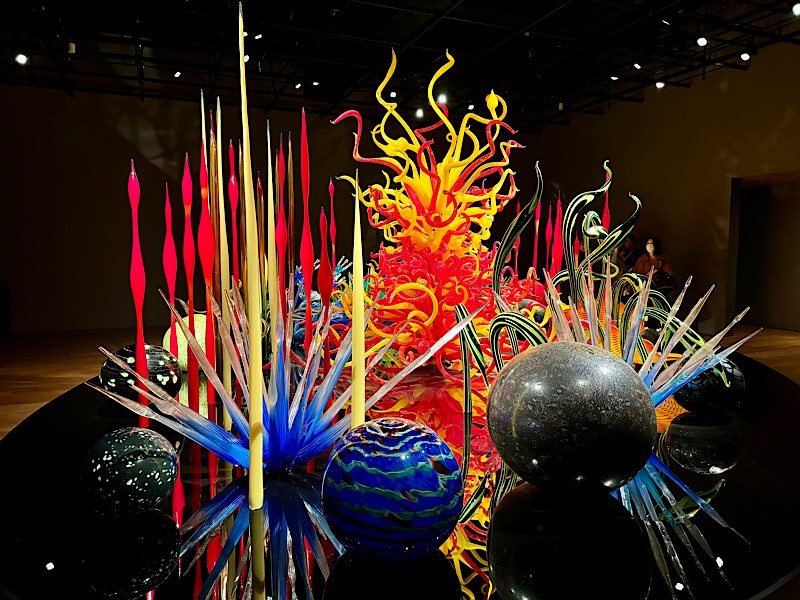
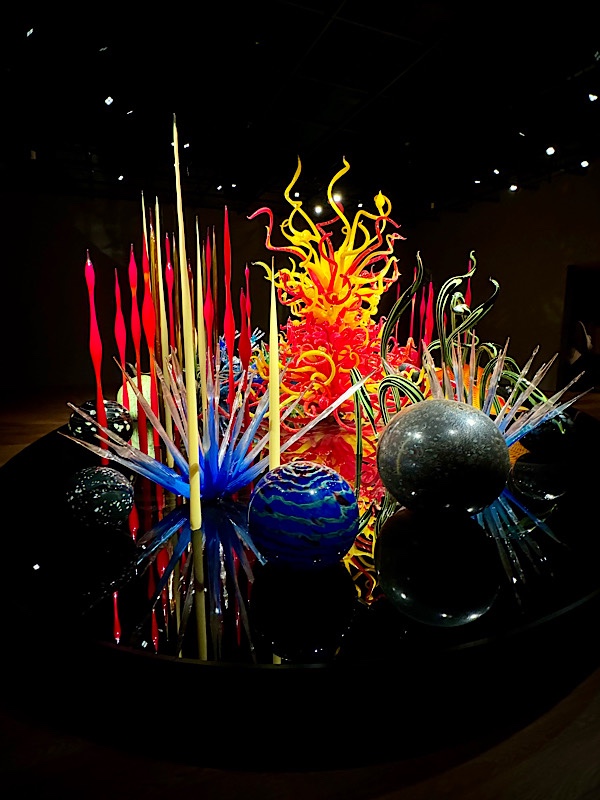 You can not deny that his work has Brough international prestige to the art sculpture and glass blowing communities – these works are visually arresting to behold.
You can not deny that his work has Brough international prestige to the art sculpture and glass blowing communities – these works are visually arresting to behold. 



 yes, I probably took far too many photos of this Mille Fiori garden – but it was so beautiful and so well curated, that I fell in love with it.
yes, I probably took far too many photos of this Mille Fiori garden – but it was so beautiful and so well curated, that I fell in love with it. 



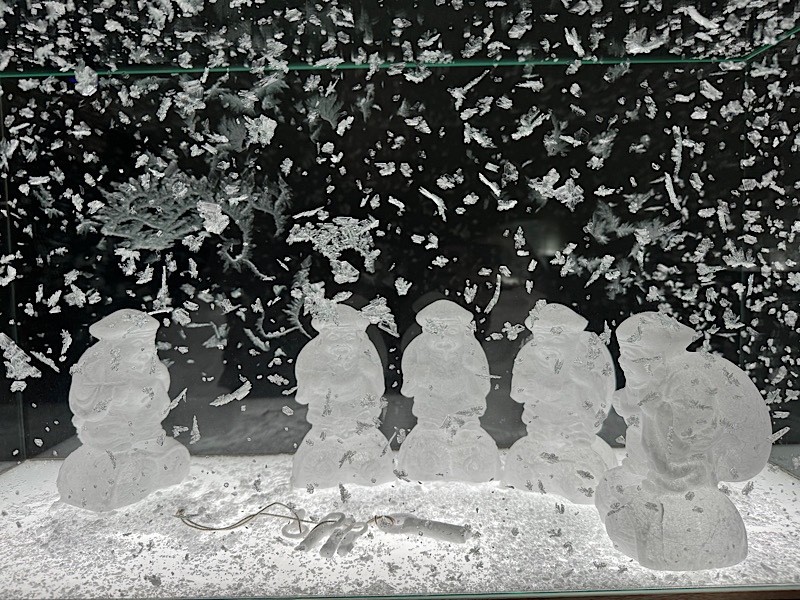

 These pieces contain a sliver of napthothene which deteriorates if exposed to oxygen – it is safety concealed in the glass and resin of the piece but would disintegrate quickly if exposed to the air… it is frozen in time, which is a central theme to the artist’s work.
These pieces contain a sliver of napthothene which deteriorates if exposed to oxygen – it is safety concealed in the glass and resin of the piece but would disintegrate quickly if exposed to the air… it is frozen in time, which is a central theme to the artist’s work. 









 Time of Migration by Fujii Yurkia, 2015
Time of Migration by Fujii Yurkia, 2015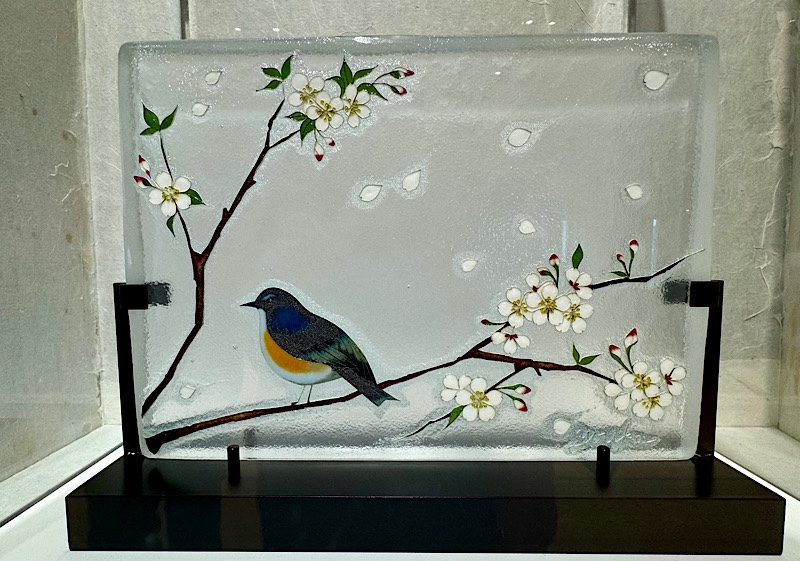

 I had a feeling this gorgeous weather wasn’t going to last and it turned out I was absolutely right.
I had a feeling this gorgeous weather wasn’t going to last and it turned out I was absolutely right. 



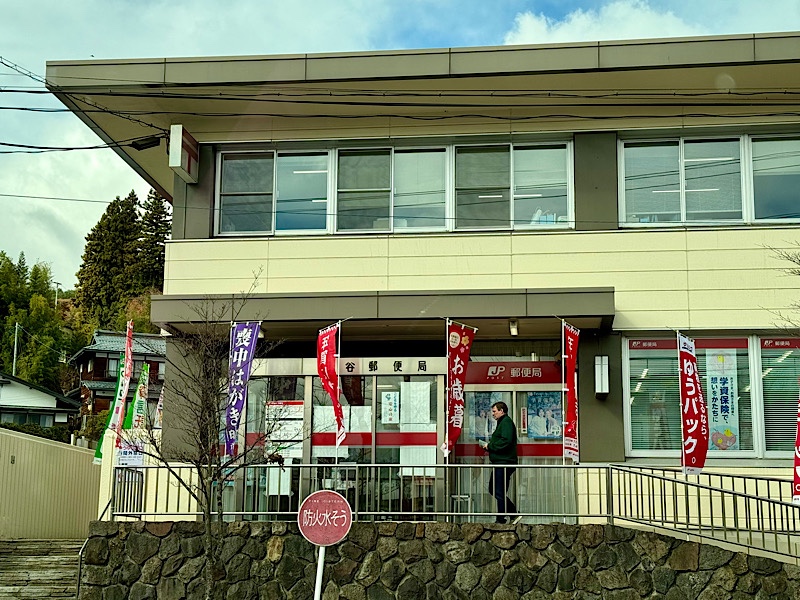 Me in the car: “There’s some snow on those mountains; I bet it’s chilly up there.” #famouslastwords
Me in the car: “There’s some snow on those mountains; I bet it’s chilly up there.” #famouslastwords
 We have noticed that Sondora shows us the topographical /literal map of things and sometimes it looks like spaghetti junction, and no sooner does that happen than you get on a highway and it turns into a graphic representation of the destinations rather than a literal visual description (*think of a London Tube map compared to the A-Z).
We have noticed that Sondora shows us the topographical /literal map of things and sometimes it looks like spaghetti junction, and no sooner does that happen than you get on a highway and it turns into a graphic representation of the destinations rather than a literal visual description (*think of a London Tube map compared to the A-Z). 

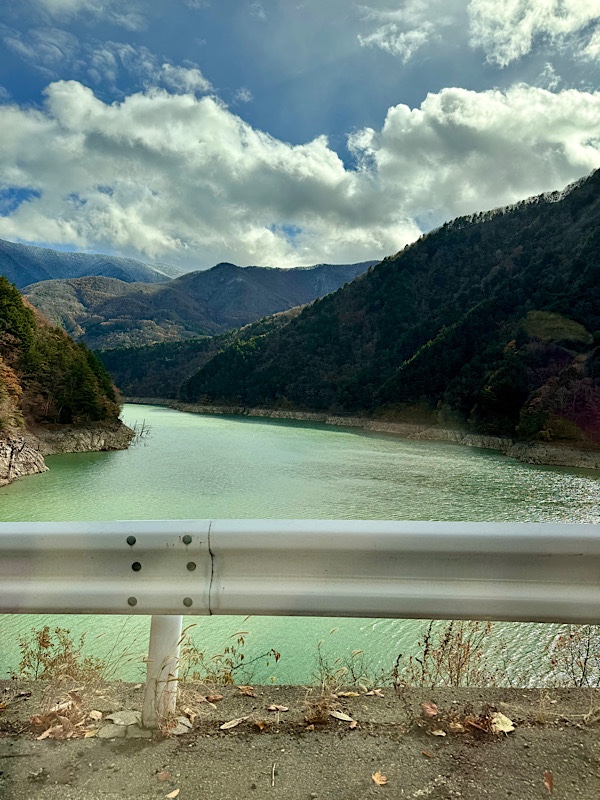 And then suddenly, it was fucking snowing! Mr K says he saw a monkey run across the road in front of us – but I think he was pulling my leg and just wanted to have one up on me.
And then suddenly, it was fucking snowing! Mr K says he saw a monkey run across the road in front of us – but I think he was pulling my leg and just wanted to have one up on me.  Beautiful!
Beautiful! We noted that Sondara was showing some pretty spaghetti/worm like road maps coming up – just what you need when it is unseasonably and unexpectably snowing on what you thought might be a fairly uneventful drive.
We noted that Sondara was showing some pretty spaghetti/worm like road maps coming up – just what you need when it is unseasonably and unexpectably snowing on what you thought might be a fairly uneventful drive.  Then we came out of a tunnel and we were up in the mountains and it was a winter wonderland! OMG – so beautiful. I haven’t seen such gorgeous scenes since we did Christmas in Canada in 2017.
Then we came out of a tunnel and we were up in the mountains and it was a winter wonderland! OMG – so beautiful. I haven’t seen such gorgeous scenes since we did Christmas in Canada in 2017. It was just so beautiful…
It was just so beautiful… 


 We stopped at a Okuhida Onsengo Kamitakara restop which had these weasels everywhere as a mascot – and we expected to find it full of weird Japanese weasel mascots and of course, fried chicken… instead we found :
We stopped at a Okuhida Onsengo Kamitakara restop which had these weasels everywhere as a mascot – and we expected to find it full of weird Japanese weasel mascots and of course, fried chicken… instead we found : 
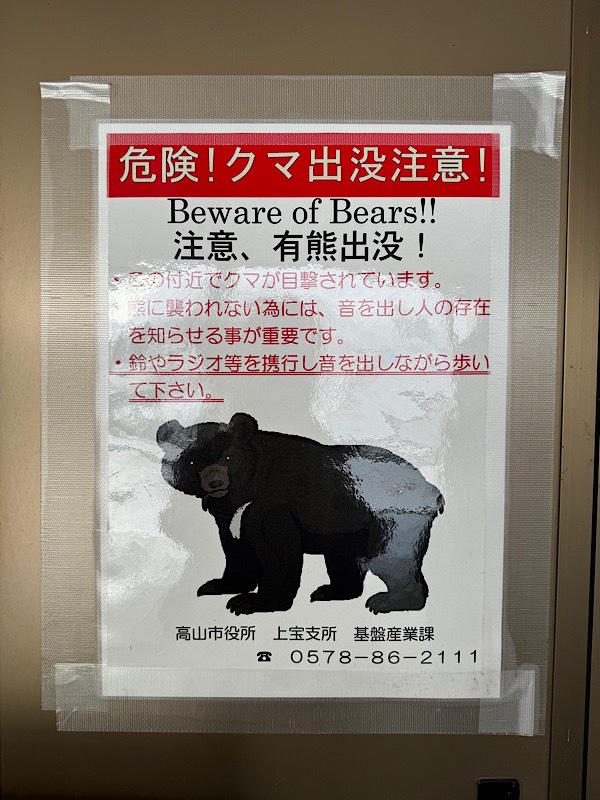

 As quickly as we entered into the snowy altitudes we were returned to the autumnal glacial alluvial valleys again.
As quickly as we entered into the snowy altitudes we were returned to the autumnal glacial alluvial valleys again.  We eventually made our way to the Dormy Inn in Toyama City – which I guess is like an American Holiday Inn or an Australian Rydges… there wasn’t much happening here by the time we arrived quite late in the day, but we did find an nice izakaya open and managed to have a nice fishy dinner. Below: miso crap, sashimi plate (salmon, snapper and yellowtail) and some sea cucumber).
We eventually made our way to the Dormy Inn in Toyama City – which I guess is like an American Holiday Inn or an Australian Rydges… there wasn’t much happening here by the time we arrived quite late in the day, but we did find an nice izakaya open and managed to have a nice fishy dinner. Below: miso crap, sashimi plate (salmon, snapper and yellowtail) and some sea cucumber). 
 Our room was on the top floor and by Western standards it was huge – by Japanese standards it was downright palatial in its generous dimensions.
Our room was on the top floor and by Western standards it was huge – by Japanese standards it was downright palatial in its generous dimensions.  Generous sitting area, dressing room, shower space, and on the balcony…
Generous sitting area, dressing room, shower space, and on the balcony…
 … another delightful onsen bath. Here the water temperature is coming out of the ground at a blistering 60C, but thankfully the were well located taps to choose the correct amount of fresh piping hot onsen mineral spring water and cold water so you could adjust the bath temperature to your liking. And if you think I didn’t bring a waterproof bath thermometer with me – you’ve obviously never met me! I’m a particularly anal retentive traveller.
… another delightful onsen bath. Here the water temperature is coming out of the ground at a blistering 60C, but thankfully the were well located taps to choose the correct amount of fresh piping hot onsen mineral spring water and cold water so you could adjust the bath temperature to your liking. And if you think I didn’t bring a waterproof bath thermometer with me – you’ve obviously never met me! I’m a particularly anal retentive traveller. 
 Maybe this is the advantage in booking a trip so far in advance – by the time you arrive you have largely forgotten what you have booked! The view from the huge living room picture window was magnificent.
Maybe this is the advantage in booking a trip so far in advance – by the time you arrive you have largely forgotten what you have booked! The view from the huge living room picture window was magnificent. 





 Shaba-Shabu… always delicious, but part of me kinda resents having to cook my own food when I’m dining out! 😉
Shaba-Shabu… always delicious, but part of me kinda resents having to cook my own food when I’m dining out! 😉 

 Unagidon was an nice unexpected surprise… it was sitting in a large clay pot simmering away when we walked in. It was not as sweet as they serve it back home; delicious.
Unagidon was an nice unexpected surprise… it was sitting in a large clay pot simmering away when we walked in. It was not as sweet as they serve it back home; delicious. 
 Then there is still more… desserts still to come.
Then there is still more… desserts still to come.  And I say desserts… for there were several.
And I say desserts… for there were several.







 The shrine itself is considered the ‘head shrine’ of some 1300 other shrines that proliferate the region.
The shrine itself is considered the ‘head shrine’ of some 1300 other shrines that proliferate the region. 
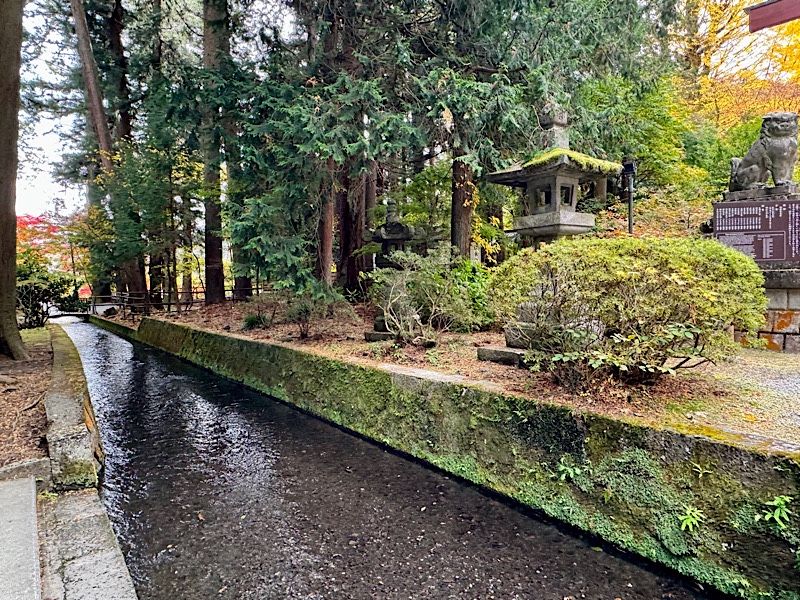



 Not for the first time, I find myself wishing I could read Japanese to see what prayers and wishes people have written on the votive wooden plaques they have left for the goddess.
Not for the first time, I find myself wishing I could read Japanese to see what prayers and wishes people have written on the votive wooden plaques they have left for the goddess. 






